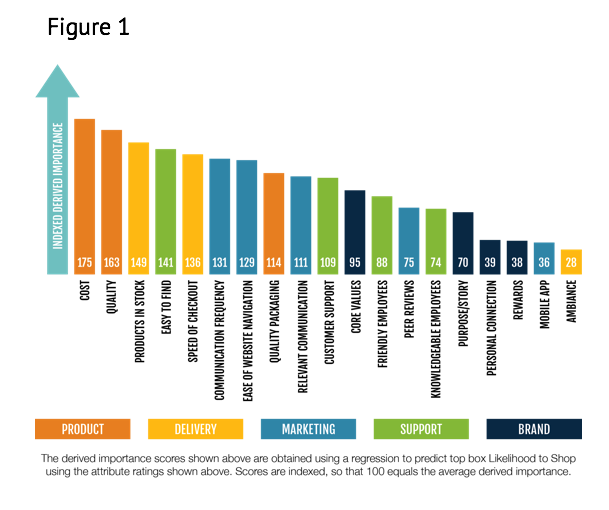Editor’s note: Lisa Brink is director, customer strategy and insights at research firm Elicit Insights, Minneapolis.
Customers engage with brands in so many different ways – they have more outlets to share their experiences and more opportunities to take their dollars elsewhere if they’re not happy. It’s generally low-risk for a customer to try something new. It only takes a few times to be delighted by another brand – or disappointed by a favorite brand – for a customer to switch their loyalties.
In order to work toward the more practical aspects of customer experience management, it is critical to first understand what customer experience means to the customers who engage with that brand. Despite the proliferation of customer experience content in the marketplace, I found very little that explored the concept from the customer’s perspective. To answer those questions, my team conducted research to pinpoint what was important to customers in their customer experience.
Likely driven by the large number of ways customers are engaging with brands today, we found that consumers view their experience as the entire collection of interactions they have with a brand, across all touchpoints (Figure 1). Some are functional, some are emotional and certainly some are more important than others. Customers are building their perspectives about a brand, and ultimately their loyalty, based on everything that happens with that brand.

This is not so different from human relationships. Think about a relationship with a best friend. It’s never one thing that defines a great friendship – it’s a collection of experiences, some more meaningful and important than others.
Relationships with customers evolve in the same way. Identifying the moments that matter most is critical. There’s only so much your brand can invest in delivering an experience and those investments should be in the areas that are most motivating to your customers.
Our research uncovered a few themes related to the customer’s definition of customer experience:
- The basics still matter: Not surprisingly, customers indicate that functional elements of product and delivery are most important. Customers want a product/service when they want it and at a quality they expect for the price that they pay. Brands need to excel at these every day.
- Package it up: The packaging of a product is experiential. Think about getting a product from Apple or a package from Anthropologie – it feels interesting and unique. For services, think of packaging as the physical space where the service takes place. How you present what you are selling is part of the experience.
- Marketing is an experience: Customers also see communication from their favorite brands – the frequency and relevance – as fairly important. This doesn’t mean that everyone wants tons of messages in every channel all the time. Rather, it means that they expect a brand to know how often and in what manner they want to communicate.
- Relevant personalization: As personalization efforts escalate, brands will become even more obsessive about collecting information about customers. The more daunting task is creating a strategy that applies that information in a way that is relevant to a customer. Personalization for personalization’s sake is of no interest.
- Stand for something: A brand’s core values play a role, not only in what a brand stands for in the marketplace but in terms of how those values show up in customer support and in employee interactions. Know how to demonstrate accountability and recover from delivering a bad experience.
While these general findings are a good place to start, it’s important to dive deeper into what matters specifically for your brand. Here are six tips for developing your own customer research:
- Survey the ones you’re with: The goal of this research is to understand how to better serve your current customers. Surveying potential customers can muddy your research objective and get in the way of understanding and uncovering what’s most important to your current customers.
- Capture a good cross section of your customers: Prior to doing this research you should have a view of your customers that helps you understand their engagement and value to the organization. Not all relationships are created equal and when interpreting this research you’re going to want to isolate the areas that matter most among those customers who have the strongest relationship with your brand.
- Don’t conduct research in a vacuum: Partner with your analytics team to study and segment your current customers on value and engagement. This will help you identify that cross section of customers you should survey. Conduct customer journey-mapping exercises with key business teams across the organization to uncover the essential customer touchpoints to study. Translate this into a list of experiences that should be rated based on importance – make sure they are discrete. Be sure to circle back with your partners to have them help you prioritize the list.
- Apply a competitive lens: If time permits in your survey, ask your customers to rate the competition’s performance on the same experience items they’re rating your brand on. Doing this allows you to ground your brand’s strengths and weaknesses compared to your competition.
- Measure, measure, measure: Once you’ve identified the critical elements in your customers’ experience, you need to establish a formal process for measuring how your brand is doing across these experiences. This measurement plan should include both primary research and analytic approaches (monitoring behaviors) and be reviewed monthly.
- Stay current: The research conducted to understand key drivers and performance is likely needed on an annual basis.
Improving experiences
Following these steps can help your company identify the elements in the experience that really matter and guide investments and resources that improve experiences in the areas that your customers care about. Getting to the heart of what matters in customer experience means putting your customers first!
